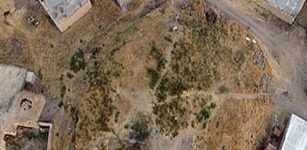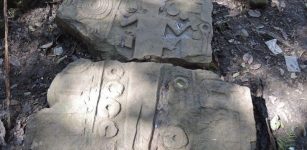One-Eyed Giant Polyphemus – Most Famous Of The Cyclops In Greek Mythology
Ellen Lloyd - AncientPages.com - Polyphemus, whose name means "abounding in songs and legends," was a famous one-eyed giant in Greek mythology. He was the son of god Poseidon and Thoosa and the most famous of the Cyclops.
Cyclops were an ancient race of giants with a single eye in the center of their forehead. They were described as builders, blacksmiths, and craftsmen.
Polyphemus is an intriguing but horrible creature mentioned in Homer's Odyssey, probably composed near the end of the 8th Century B.C.
The classical Greek poem describes the Greek hero Odysseus (or Ulysses, as he was known in Roman myths) and his long journey home to Ithaca following the fall of Troy.
Odysseus traveled to distant countries for ten years and encountered remarkable people and creatures. His journey took him through the Ionian Islands and the Peloponnese and as far away as Egypt, North Africa, and the western Mediterranean, as the displeased sea-god Poseidon prevented him from reaching his home.
In Homer’s epic, we learn how Odysseus encountered the one-eyed Polyphemus on his return from Troy. The Greek hero and his men came across a cave and decided to enter it. Inside the cave, they ate and rested until they finally fell asleep.
Amphora painting of Odysseus and his men blinding Polyphemus (Eleusis museum) Credit: Wikipedia
When Polyphemus returned to his cave, he found the intruders and became furious. Odysseus and his friends could not escape because the giant had rolled a huge stone against the mouth of the cave to close the entrance. The furious Cyclops grabbed two of the men and ate them. The next morning, the giant left the cave to graze his sheep. When the giant returned in the evening, he ate two more of the captive men.
Odysseus offered Polyphemus some strong and undiluted wine given to him earlier on his journey. Before passing out, the giant asked Odysseus’ name and was told the Greek hero’s name was “Nobody.”
As Polyphemus was sleeping, the Greek hero took a wooden stake in the fire and drove it into the giant’s eye, making him blind. Polyphemus screamed for help, and the other Cyclops on the island came running. They asked him who had done this to him, and the giant replied, “Nobody.” Hearing this, the other Cyclops all returned home laughing. They thought Polyphemus was afflicted by divine power and recommended prayer as the answer.
In the morning, the blind Cyclops let the sheep out to graze. With his hand, he checked their backs to ensure the men were not escaping. However, Odysseus and his men had tied themselves to the undersides of the animals and managed to get away.
The Blinding of Polyphemus - Pellegrino Tibaldi (1527-1596)
When Odysseus was on his ship, he boastfully revealed his real name. This turned out to be unwise because the one-eyed giant Polyphemus prayed to his father, the sea-god Poseidon, asking for revenge. Poseidon was angry about what had happened to his son. He persecuted Poseidon and persecuted Odysseus at sea, throwing huge rocks toward the ship, which Odysseus barely escaped.
The story of Polyphemus became a favorite of classical poets and sculptors, inspiring a play by Euripides (“The Cyclops”) and appearing in the Aeneid of Virgil.
Ovid also popularized it in his Metamorphoses, but the story has a different ending. Ovid wrote that Polyphemus and Galatea married, and from their offspring were born several “savage” races, including the Celts, the Gauls, and the Illyrians.

Arimaspians: Mysterious Mighty One-Eyed People From The North
Ancient myths and legends about mysterious one-eyes people are not uncommon. For example, Greek records mention the Arimaspians, a tribe of normal human-sized horsemen with only one eye in the middle of their forehead.
Updated on July 27, 2022
Written by Ellen Lloyd – AncientPages.com
Copyright © AncientPages.com All rights reserved. This material may not be published, broadcast, rewritten or redistributed in whole or part without the express written permission of AncientPages.com
Expand for referencesMore From Ancient Pages
-
 Enigmatic Voynich Manuscript: Computer Scientists From Alberta Use AI To Decipher Document
Archaeology | Jan 31, 2018
Enigmatic Voynich Manuscript: Computer Scientists From Alberta Use AI To Decipher Document
Archaeology | Jan 31, 2018 -
 Easter Island Holds Clues To The Disappearance Of People On The ‘Mystery Islands’
Archaeology | May 14, 2021
Easter Island Holds Clues To The Disappearance Of People On The ‘Mystery Islands’
Archaeology | May 14, 2021 -
 Viking Burial Rituals: High Ancient Funeral Pyre Reflected High Social Status
Ancient Traditions And Customs | Mar 13, 2017
Viking Burial Rituals: High Ancient Funeral Pyre Reflected High Social Status
Ancient Traditions And Customs | Mar 13, 2017 -
 Clay-Jar Tombs With Child Corpses – Unearthed In Northwest Iran
Archaeology | Jun 28, 2020
Clay-Jar Tombs With Child Corpses – Unearthed In Northwest Iran
Archaeology | Jun 28, 2020 -
 Stone Tools In Lapa do Picareiro Cave Reveal Modern Humans Reached Western Parts Of Europe 5,000 Years Earlier Than Previously Thought
Archaeology | Sep 30, 2020
Stone Tools In Lapa do Picareiro Cave Reveal Modern Humans Reached Western Parts Of Europe 5,000 Years Earlier Than Previously Thought
Archaeology | Sep 30, 2020 -
 10 Remarkable Jain Temples – Marvelous Ancient Architecture And Stone Carvings
Featured Stories | Dec 17, 2015
10 Remarkable Jain Temples – Marvelous Ancient Architecture And Stone Carvings
Featured Stories | Dec 17, 2015 -
 Gold Coins Shed Light On The Mystery Of Sandby Borg And Massacre On The Swedish Island
Archaeology | Oct 16, 2017
Gold Coins Shed Light On The Mystery Of Sandby Borg And Massacre On The Swedish Island
Archaeology | Oct 16, 2017 -
 On This Day In History: Statue Of Venus de Milo Is Discovered On The Aegean Island Of Milos – On Apr 8, 1820
News | Apr 8, 2016
On This Day In History: Statue Of Venus de Milo Is Discovered On The Aegean Island Of Milos – On Apr 8, 1820
News | Apr 8, 2016 -
 Underground Catacombs Of Alexandria: Ancient Time Capsule Which Remained Hidden For Almost Two Millennia
Featured Stories | Sep 20, 2016
Underground Catacombs Of Alexandria: Ancient Time Capsule Which Remained Hidden For Almost Two Millennia
Featured Stories | Sep 20, 2016 -
 Ancient Mystery Of Giant Mounds Of Jerusalem Built For Unknown Reasons – Archaeologists Are Still Baffled
Archaeoastronomy | Aug 24, 2020
Ancient Mystery Of Giant Mounds Of Jerusalem Built For Unknown Reasons – Archaeologists Are Still Baffled
Archaeoastronomy | Aug 24, 2020 -
 Earliest Record Of An Aurora Discovered In The Bamboo Annals
Archaeology | Apr 15, 2022
Earliest Record Of An Aurora Discovered In The Bamboo Annals
Archaeology | Apr 15, 2022 -
 On This Day In History: Mathematician And Astronomer Christiaan Huygens Born – On Apr 14, 1629
News | Apr 14, 2017
On This Day In History: Mathematician And Astronomer Christiaan Huygens Born – On Apr 14, 1629
News | Apr 14, 2017 -
 Middle Iron Age And Roman Period Buildings And Relics Discovered In Bedfordshire, UK
Archaeology | Feb 27, 2022
Middle Iron Age And Roman Period Buildings And Relics Discovered In Bedfordshire, UK
Archaeology | Feb 27, 2022 -
 Dunstanburgh Castle: Underground Passageways And The Legend Of Sir Guy The Seeker
Featured Stories | Apr 5, 2016
Dunstanburgh Castle: Underground Passageways And The Legend Of Sir Guy The Seeker
Featured Stories | Apr 5, 2016 -
 6,000-Year-Old Discovery Of Artifacts Associated With Ancient Lengyel Culture
Archaeology | Mar 27, 2020
6,000-Year-Old Discovery Of Artifacts Associated With Ancient Lengyel Culture
Archaeology | Mar 27, 2020 -
 What Is Pax Sinica?
Ancient History Facts | Apr 26, 2018
What Is Pax Sinica?
Ancient History Facts | Apr 26, 2018 -
 Mystery Of The Unique Tiarp Dolmen – One Of Oldest The Stone Burial Chambers In Scandinavia
Archaeology | Jan 30, 2024
Mystery Of The Unique Tiarp Dolmen – One Of Oldest The Stone Burial Chambers In Scandinavia
Archaeology | Jan 30, 2024 -
 Mystery Of The Ancient Forgotten Mizoram Civilization And Lost City Of Vangchhia
Civilizations | Jun 16, 2020
Mystery Of The Ancient Forgotten Mizoram Civilization And Lost City Of Vangchhia
Civilizations | Jun 16, 2020 -
 Surprising Discovery – Replica In The Field Museum Is A 3,000-Year-Old Sword
Artifacts | Jan 18, 2023
Surprising Discovery – Replica In The Field Museum Is A 3,000-Year-Old Sword
Artifacts | Jan 18, 2023 -
 Mythical Stymphalian Birds: Terrible Winged Maidens With Birds’ Feet
Featured Stories | Feb 27, 2017
Mythical Stymphalian Birds: Terrible Winged Maidens With Birds’ Feet
Featured Stories | Feb 27, 2017



